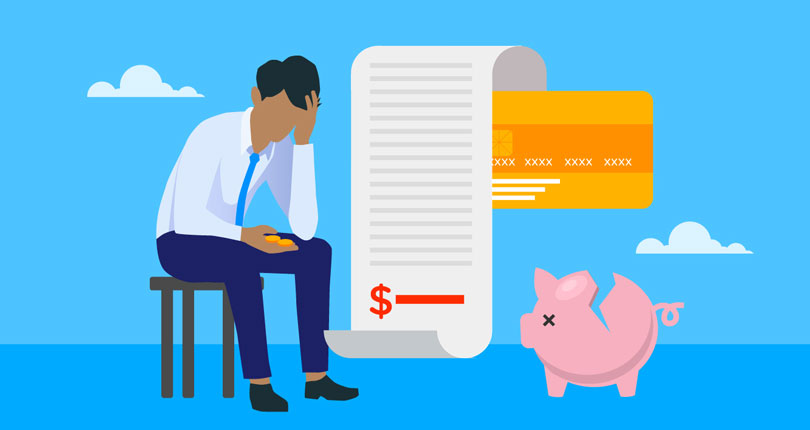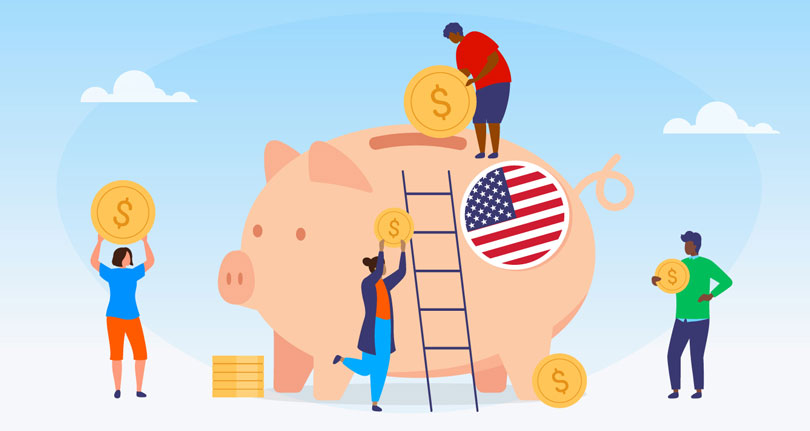Inflation Spending Habits
Inflation began gradually rising in the U.S. in mid-2021, hitting a peak of 9.1% in June 2022 according to Consumer Price Index (CPI) Data from the Bureau of Labor Statistics (BLS). This is the highest rate of inflation since the early 1980s.
The average inflation rate throughout 2023 was 4.2%, with a high of 6.4% in January and a low of 3% in June. Although the rate of inflation has dropped, prices continue to rise at a higher rate than they did in early 2021, with these price increases affecting consumers in several ways. [1] 12-Month Price Change, Consumer Price Index - BLS https://www.bls.gov/charts/consumer-price-index/consumer-price-index-by-category-line-chart.htm
A survey on behalf of Self sought to find out how inflation-related price increases had affected the way people make purchases, and whether their spending habits had changed.
Key statistics
- The vast majority (96.7%) of people say their spending habits have changed as a direct result of inflation.
- On average, people’s typical grocery shop has increased by $40.64 compared to what they paid in 2021.
- Families with children have changed their spending habits the most, with 95.3% of people with children saying they are buying less food to keep costs down, compared with 75% of families without children.
- 89% of people have started purchasing more items from the clearance section at the grocery store in the past year.
- More than half (57.6%) of shoppers are buying less fruit and vegetables to save money after inflation-related price increases.
- 84.9% of people have canceled entertainment subscriptions like streaming and music services to save money.
- The vast majority (94.9%) of people say they plan to keep up with at least some of their current spending habits, even if inflation reduces.
Has spending changed as a result of inflation?
Over half (57.1%) of respondents said that their spending habits had changed considerably as a direct result of inflation, while 39.5% said their spending habits had changed a little. Only 3.3% said their spending had not changed at all as a result of inflation.
When asked whether they planned to keep up their current spending habits if inflation reduces, 53.4% said they would keep up some of these habits, 41.5% said they would keep all of their new spending habits, while 5.1% said they would not keep any of these habits.
A change in grocery shopping habits
Food inflation in the U.S. hit a peak of 11.4% in August 2022, after rising consistently since May 2021. Although food inflation decreased every month in 2023, there was still an average inflation rate of 6.1% across the year. The rate of inflation fell from 10.1% in January to 2.9% in November, meaning food prices are still rising but at a much slower rate. [1] 12-Month Price Change, Consumer Price Index - BLS https://www.bls.gov/charts/consumer-price-index/consumer-price-index-by-category-line-chart.htm
So, how has inflation during this period impacted people’s food shopping habits?
Most people (57.7%) said they are buying considerably less food to keep costs down. An additional 36.2% said they were buying a little less food to keep their grocery shopping costs down.
More data from the survey shows that families with children have been most affected by inflation-related price increases on food.
For respondents with children under 18 years old, 95.3% said they were buying less food to keep costs down, this is compared with 75% of people who don’t have children at home.
Most people have seen an increase in their typical grocery bill
Since 2021, the majority of people surveyed (98.2%) say that their usual grocery bill has increased in price. Over half (54.4%) of respondents say their grocery shop has increased by between $30 and $50. Just 1.8% of people said the price of their grocery shop hasn’t increased at all.
The average price increase on grocery shopping cited by survey respondents is $40.64.
In addition to this, 57.1% of people said they were buying cheaper food products than they used to for many of their usual items, due to a rise in overall prices. 37.3% said they were choosing cheaper options, but only for a few of their usual items, while 5.7% said they were still largely shopping the same for their normal food items.
A switch from branded to non-branded products
Most shoppers say they have switched from branded to non-branded products for at least some of their food items, with 45.5% saying they have switched to non-brand for 4-6 items on their usual shopping list.
4.55% say they have swapped more than 10 branded items to non-branded ones to save money on their grocery shop. Only 4.6% of people say they have not swapped any of the branded products they usually buy.
More than four in five (84%) say they have switched grocery stores to try and find cheaper alternatives to their usual purchases, while 82.9% now shop at multiple grocery stores to find the cheapest prices.
Alongside switching to non-brand products, 89% of people say they have started purchasing more clearance items at the grocery store in the past year.
Are people changing their eating habits to save money?
Three in ten (31.7%) respondents say they are eating less food to save money on groceries since inflation caused prices to increase. Over four in five (83.6%) say they have started using more coupons for purchases in the past year than they had done previously.
Over four in five (83.4%) say they are freezing leftovers to eat later to help save money due to rising food costs. A similar amount of respondents say they have changed the kinds of meals they cook to save money.
Over half of shoppers are buying less fruit and vegetables to save money
Survey results show that 57.6% of people have started buying less fresh fruit and vegetables to save money since prices began increasing. This is the most common food type people say they are buying less of as a result of inflation. This is followed by fish (51%), meat (43.6%) and chocolate and candy (36.9%). Only 8.1% of people say they are buying fewer alcoholic drinks to save money on their grocery shop.
| Food product |
% who are buying less to save money |
| Fresh fruit and vegetables |
57.6% |
| Fish |
51% |
| Meat |
43.6% |
| Chocolate and candy |
36.9% |
| Dairy products |
18.5% |
| Alcoholic drinks |
8.1% |
Although fresh fruit and vegetables came top of the list of food people were buying less of, 86.8% of respondents also said they were buying more frozen fruits, vegetables, and meats rather than fresh products to reduce costs. A further 86.3% say they are replacing some of their meat intake with vegan options like lentils and legumes to save money as a result of inflation.
People will buy lower-quality food to reduce costs
Most of those surveyed (57.8%) say they will be willing to compromise on food standards or buy lower-quality food for all of the products they buy to save money. A further 36.3% said they would compromise on food standards but only for some food products.
Just 5.9% of people said they would not compromise on food standards to save money on any products at all.
Takeout food spending habits
These survey results show that 45.2% of people are ordering more takeout food than they have done previously, while 37.8% are ordering less, and 17% are ordering the same.
It’s possible that this change could be due to people eating out less at restaurants as a result of the higher cost of living, and therefore ordering more takeout meals as a way of having a treat at a lower cost. Data from the third quarter of 2023 shows that visits to full-service dining restaurants were down by 4.7% YoY. [2] White Paper Recap November 2023 - Placer.ai https://www.placer.ai/blog/placer-ai-white-paper-recap-november-2023
A change in spending on entertainment
Around half of people (48.6%) say they have reduced the amount of entertainment they pay for in the past two years, while only slightly fewer (43%) say they are spending more on entertainment compared to two years ago. Many people are likely spending more on these services due to a crackdown on sharing passwords on platforms like Netflix, and price hikes across a number of providers. [3] Netflix’s Password Sharing Crackdown Reels in New Subscribers - AP News https://apnews.com/article/netflix-price-increase-password-sharing-results-d2c942bce7ec2c574ca148c8661ccaf0
These changes have led to many users simply canceling their subscriptions rather than paying more for the same or reduced services.
The majority of respondents (84.9%) have canceled entertainment subscriptions including streaming and music services to save money.
People are changing how they buy clothes
85.3% of respondents have noticed an increase in the price of clothing and accessories in the past two years with almost two-thirds (64.3%) saying they are buying fewer of these items due to increasing prices.
As a result, a lot of people have changed where they buy their clothes to save money. 37.9% of people say they are buying more second-hand clothes, while 37.2% are buying more from thrift stores, and 18.6% are buying more of their clothes from more affordable stores and websites.
However, 82.2% of people say they have started purchasing more low-quality, ‘fast-fashion’ clothing items rather than quality clothing to try and save money.
Over a third (37.9%) of people say they buy more second-hand clothes now, perhaps using apps like Depop which has 30 million registered users and over 200,000 active sellers as of 2023. [4] 11 Depop Statistics Showing Their Mind Blowing Growth - Etsy Marketer https://etsymarketer.com/depop-statistics/
Most people (85.8%) now make more of an effort to repair their clothes instead of throwing them away to save money, more so than they did before inflation caused prices to increase.
Methodology
A survey of 1,078 Americans was carried out in November 2023 to ask questions about spending habits relating to inflation.
Sources






